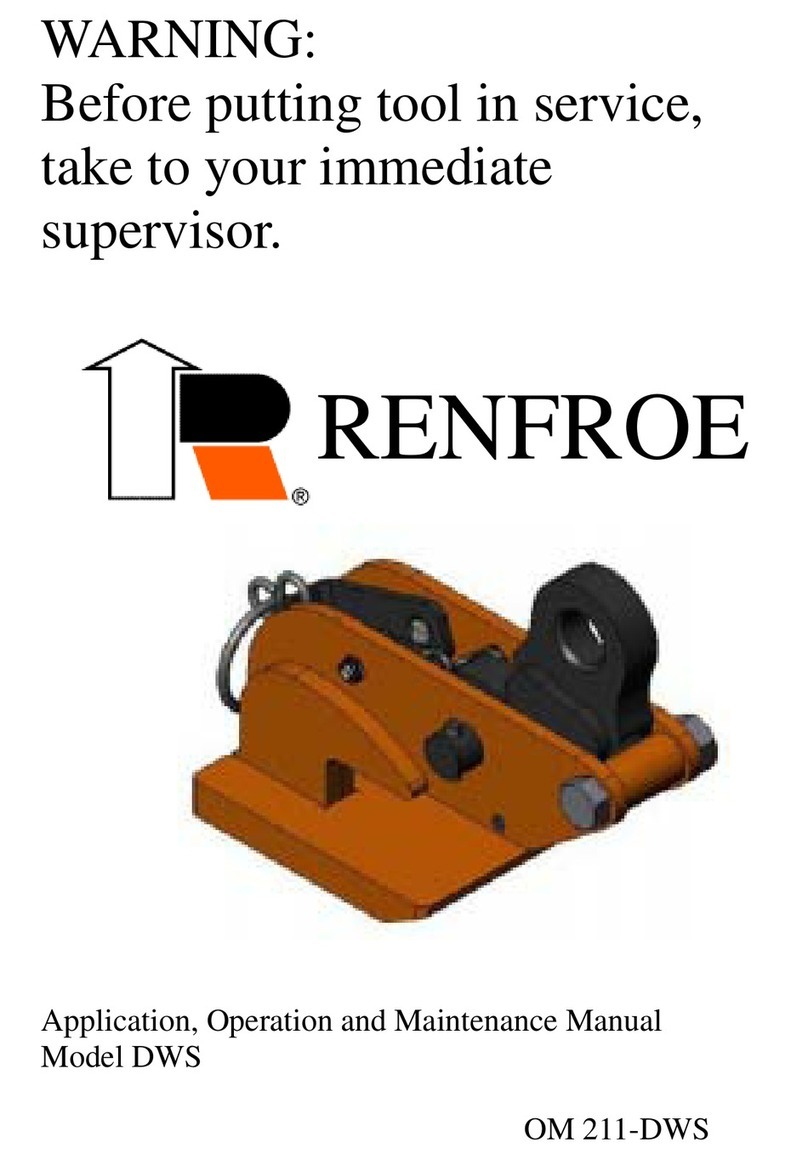
handle is moved to unlocked position
the force exerted by the spring is re-
laxed and the gripping cam may be re-
tracted by pushing the lifting shackle
into body of clamp. Refer to the Opera-
tion Section of specific models of “Lock
Closed” clamps for additional details.
Typical “Lock Closed” clamps are Mod-
els DG, FR and M.
“LOCK OPEN ONLY” - normally used
on “Hot Lift” clamps and consists of a
manually operated “Lock Stop Pin” that
is inserted when gripping cam of clamp
is retracted and removed when clamp is
positioned on the plate. Tag line may
be used to permit operator to remove
pin from a greater distance from clamp.
Refer to the Operation Section of spe-
cific model of “Lock Open Only” clamps
for additional details. Typical “Lock
Open Only” clamp is the Model RO.
“LOCK OPEN-LOCK CLOSED” - an
over-center spring loaded mechanism in
which the spring exerts a force on the
gripping cam when the lock handle is
moved to the “Lock Closed” position.
When the handle is moved to the “Lock
Open” the gripping cam is maintained in
the retracted position for ease in install-
ing the clamp on a plate or member.
The Model FRD contains individual
“Lock Open” and “Lock Closed” mecha-
nisms that must be operated separately.
Refer to the Operation Section of spe-
cific models of the “Lock Open-Lock
Closed” clamps for additional details.
Typical “Lock Open-Lock Closed”
clamps are Models FRD, R, S, SD,
SEA, SX, TL, TLA and the J-Series.
“LOCKING WEDGE” - is a fluted steel
wedge that is driven in place with a
hammer. The body of the wedge is
positioned in a slot in the clamp body
with the fluted edges contacting the
member to which the clamp is being
attached. Refer to Operation Section
of specific models of the “Locking
Wedge” clamps for additional details.
Typical “Locking Wedge” clamps are
Model A1, B1, B2 and PB.
”Locking Screw” - “Lock Screw” clamps
depend on manually adjusting a screw
to hold the gripping surface in place for
lifting and removing the clamp from
member being lifted. Refer to Operation
Section of a specific model of “Locking
Screw” clamps for additional details.
Typical “Locking Screw” clamps are
Models AC, ACP, NM, PC, SCP and
SCPA.
NON-LOCKING: “Non-Locking” clamps
have no mechanisms to aid in attaching
or removing clamp from member being
lifted. It is necessary to have position of
clamp maintained on the member being
lifted until a properly applied force is
exerted to the lifting shackle. Refer to
Operation Section of specific models of
the “Non-Locking” clamps for additional
details. Typical “Non-Locking” clamps
are Model AST, ASTL, BD, HR, HDR
and WHSR. WARNING: A pointing out
and notice of danger. The purpose of a
“WARNING” is to apprise the operator
and all other affected persons of the
existence of danger of which he should
be but may not be aware and to enable
the operator to protect himself and oth-
ers where applicable against such dan-
ger. An attempt is made herein to warn
against reasonable and reasonably
foreseeable danger in the proper use
and possible reasonable misuse of
RENFROE products described in this
manual.




























